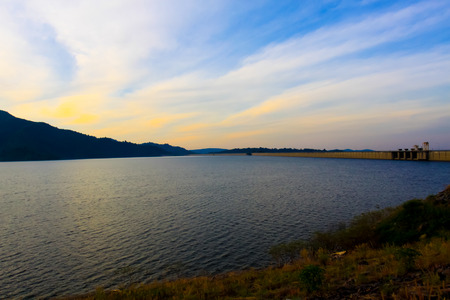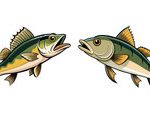Chasing Largemouths in the Land of Red Rocks
When most people think of bass fishing, they picture green lakes in the Midwest or Southeast. But out in the American Southwest, the desert tells a different story. In states like Arizona, New Mexico, and Utah, tucked between towering red rock formations and wide-open skies, youll find some of the most unexpected—and rewarding—largemouth bass fishing spots around.
The Secret Life of Desert Reservoirs
These desert lakes might not look like your typical bass haven, but don’t let the dry landscape fool you. Man-made reservoirs created for irrigation, water storage, or flood control have turned into thriving ecosystems. Thanks to warm temperatures, clear water, and an abundance of forage like bluegill and crayfish, largemouth bass can grow big—and fast—in these remote waters.
Top Desert Bass States at a Glance
| State | Popular Reservoirs | Why It’s Productive |
|---|---|---|
| Arizona | Lake Havasu, Roosevelt Lake | Warm water year-round, strong forage base |
| New Mexico | Elephant Butte Lake, Ute Lake | Mild winters, rocky structure for ambush points |
| Utah | Lake Powell, Sand Hollow Reservoir | Clearness of water helps sight fishing; good vegetation cover |
The Role of Geography in Bass Behavior
The high desert terrain creates unique underwater structures—think steep drop-offs, submerged boulders, and canyon-like ledges. These features give largemouth bass plenty of places to hide and hunt. Plus, with less fishing pressure than more well-known areas back East, fish here are often more aggressive and willing to strike.
Bass Fishing Benefits in Desert Lakes:
- Mild Winters: Longer growing seasons lead to larger fish.
- Diverse Structure: Natural and man-made features provide excellent cover.
- Crisp Water Clarity: Ideal for sight-fishing techniques.
- Sparse Crowds: Less competition from other anglers means more action.
Tactics That Work in the Southwest Heat
If youre heading into the backcountry for some desert bass fishing, pack light but smart. Soft plastics in natural colors work wonders in clear water. Drop shot rigs and Texas rigs are go-to techniques for rocky bottoms. And when the sun dips low? Topwater lures can trigger explosive strikes near brushy shorelines or submerged trees.
Largemouth bass may not be native to these arid regions, but theyve certainly made themselves at home. With the right approach and a little desert grit, youll find that chasing bass in the land of red rocks is more than just an adventure—its a whole new way to experience the sport.
2. Gear Up for the Desert
Fishing in the remote deserts of the American Southwest isn’t your average bass trip. It’s about prepping smart and packing light—but with the right tools to handle extreme heat, rocky terrain, and zero cell signal. Here’s a practical guide to essential gear that’ll keep you safe, cool, and ready to reel in that desert largemouth.
Heat-Ready Rods and Reels
Desert temps can soar above 100°F, so your gear needs to be tough. Go for graphite or composite rods—they’re lightweight and hold up well under UV exposure. For reels, choose sealed bearings and corrosion-resistant materials like anodized aluminum. The dry heat won’t rust metal like coastal saltwater, but sand can still wreak havoc.
Recommended Rod and Reel Features
| Gear | Key Feature | Why It Matters |
|---|---|---|
| Rod (Graphite/Composite) | Lightweight & Heat Durable | Easy to carry on long hikes; resists warping in high temps |
| Reel with Sealed Bearings | Dust Protection | Keeps desert sand out of moving parts |
| Anodized Aluminum Components | Corrosion Resistance | Withstands dry environments and sudden temp changes |
Hydration Is Half the Battle
You cant chase bass if youre dehydrated. Always carry more water than you think youll need—at least one gallon per person per day is a good rule of thumb. Use insulated hydration packs or stainless steel bottles to keep water cooler longer. Electrolyte tablets or powder packs are also smart additions to prevent heat exhaustion.
Hydration Tips for Backcountry Anglers
- Hydration Bladder (2–3L): Easy to sip while hiking or casting.
- Stainless Steel Bottle: Keeps water cold even after hours in the sun.
- Electrolyte Packs: Replace salts lost from sweating in extreme heat.
- Purifier Straw or Filter: A backup if you find a natural water source.
Navigating Off-the-Grid Waters
The best desert bass spots are usually far from cell towers. Bring a GPS unit designed for outdoor use or download offline maps on your phone before heading out. A physical topographic map and compass should always be your backup plan—batteries die fast in extreme heat.
Navigation Essentials Checklist
- Handheld GPS: Rugged, with topo maps loaded for the region.
- Offline Mapping App: Try Gaia GPS or OnX Hunt with downloaded tiles.
- Compass & Map: Old-school but reliable when tech fails.
- Solar Charger: Keeps devices powered when youre off-grid for days.
Packing Smart: Other Must-Haves
A successful desert fishing trip depends on more than just rods and reels. Heres a quick list of other essentials worth adding to your pack:
- Sunscreen (SPF 50+): Reapply often—desert sun is unforgiving.
- Sunglasses (Polarized): Cut glare off the water surface and protect your eyes.
- Wide-Brim Hat & Buff: Keep your face and neck shaded all day long.
- Trekking Poles: Helpful on uneven canyon trails leading to hidden water holes.
- Lip Balm with SPF: Dont forget about sunburned lips!
- Duct Tape & Multi-Tool: Fix almost anything in a pinch—from broken rods to torn boots.
The desert may be harsh, but it rewards those who come prepared. With the right gear and mindset, these remote waters can offer some of the most memorable bass fishing you’ll ever experience.
![]()
3. Seasonal Strategies in a Harsh Climate
Fishing for bass in the American Southwest isn’t just about finding water—it’s about understanding how the seasons shape fish behavior and conditions. From spring snowmelt to scorching summer heat, each season brings its own challenges and opportunities. Here’s how you can adjust your approach throughout the year.
Spring: The Sweet Spot
As desert temperatures begin to rise and snowmelt feeds into reservoirs and backcountry ponds, bass become more active. This is prime time for anglers. Water temps climbing into the 60s trigger spawning behavior, drawing bass into shallower waters where they’re easier to target.
Tips for Spring Bass Fishing:
- Focus on shallow flats and rocky shorelines where bass are bedding.
- Use soft plastics like creature baits or lizards—natural colors work best in clear water.
- Morning and late afternoon offer cooler, more active windows.
Summer: Surviving the Heat
Summer in the desert can be brutal, with daytime temps often soaring above 100°F. Bass retreat to deeper, cooler water during midday but will move into shallows during early morning and evening hours when temperatures drop slightly.
Key Tactics for Summer:
| Time of Day | Best Locations | Lure Suggestions |
|---|---|---|
| Dawn & Dusk | Shallow coves, weed lines | Topwater poppers, frogs |
| Midday | Deeper channels, shaded structure | Drop shot rigs, deep-diving crankbaits |
Late Summer & Early Fall: Drought Conditions
By late summer, many backcountry waters recede due to lack of rainfall and high evaporation rates. This concentrates fish but also makes them wary. Water clarity can increase as levels drop, so finesse techniques become more effective.
Tactics for Low-Water Conditions:
- Downsize your presentation—use smaller baits and lighter line.
- Creep your retrieve—slow and subtle movements often get more bites.
- Look for submerged springs or cooler inflow areas that hold oxygen-rich water.
Pro Tip:
If youre hiking into remote spots during these hotter months, pack light but don’t skimp on hydration—desert dehydration is no joke.
No matter the season, knowing how bass react to changing desert conditions helps you stay ahead of the game. Adapt your tactics, respect the environment, and you’ll find success even in the harshest corners of the Southwest.
4. Off-the-Grid Hotspots and Hidden Lakes
If youre looking to escape the crowds and tap into some of the most rewarding bass fishing in the American Southwest, its time to explore off-the-grid hotspots. These are remote desert waters—small reservoirs, hidden lakes, and spring-fed oases—that often require a high-clearance vehicle or even a good hike to reach. But for those willing to put in the effort, these places offer peaceful solitude and surprisingly strong bass action.
Scout Remote Fishing Locations
The first step is knowing where to look. Many hidden gems are tucked away on public lands managed by the Bureau of Land Management (BLM) or National Forest Service. These areas may not appear on typical tourist maps but can be found with more detailed resources:
Recommended Map Resources:
| Resource | Description |
|---|---|
| OnX Hunt | Shows land ownership boundaries and trail access points; great for finding legal entry to remote areas. |
| USGS Topographic Maps | Offers detailed elevation data and water features—perfect for spotting small reservoirs or ponds. |
| GAIA GPS | GPS-enabled app with layers for trails, terrain, and public land overlays. |
Accessing Desert Backcountry Waters
Most of these fishing spots are only accessible via dirt roads or hiking trails. Make sure your vehicle is equipped for rough terrain, and always check road conditions before heading out. In some cases, you may need to hike a mile or more with your gear—so pack light but smart. A compact rod setup and a small backpack with tackle essentials will do the trick.
Backcountry Access Tips:
- Bring printed maps as backup in case GPS fails.
- Let someone know your plans before venturing out.
- Carry plenty of water—desert heat can sneak up fast.
- Watch for seasonal closures or fire restrictions on public lands.
Ethical Fishing Practices in Remote Areas
When fishing off the beaten path, it’s important to follow Leave No Trace principles. Pack out everything you bring in, including fishing line and bait containers. Respect private property boundaries and avoid disturbing wildlife habitats. If youre catch-and-release fishing, handle bass carefully and return them gently to the water.
Quick Ethical Checklist:
- No littering—carry a trash bag with you.
- Avoid creating new trails; stick to existing paths.
- Use barbless hooks if practicing catch-and-release.
- Keep noise levels down—preserve the wilderness experience for others.
The American Southwest is full of secret desert lakes just waiting to be discovered. With the right tools, knowledge, and respect for nature, you can enjoy some of the best bass fishing far from the crowds—and maybe even have an entire lake all to yourself.
5. The Spirit of the Southwest Fish Camp
Out in the wide-open deserts of the American Southwest, bass fishing is more than just catching fish—its about living the adventure. After a long day casting into remote canyon lakes or winding desert rivers, nothing beats setting up camp under a sky full of stars. Welcome to fish camp, Southwest style.
The DIY Desert Camp Setup
Desert fish camps are all about simplicity and self-reliance. You don’t need fancy gear—just a reliable truck, a cooler full of essentials, and a love for the outdoors. Most anglers set up near the water’s edge, using their tailgates as kitchen counters and their camp chairs as front-row seats to some of nature’s best sunsets.
| Essential Gear | Purpose |
|---|---|
| Pop-up Shade Tent | Protection from intense desert sun |
| Cooler with Ice | Keeping drinks cold and storing fresh catches |
| Portable Grill | Cooking up burgers, dogs, or your catch of the day |
| Headlamp or Lantern | Lighting after sunset for night fishing or storytelling |
| Tarp or Ground Mat | Campsite comfort and dust control |
Tailgate Grilling & Campfire Stories
The tailgate becomes your kitchen when you’re out in the backcountry. Nothing says “Southwest fish camp” like grilling over open flames—whether its foil-wrapped bass filets seasoned with lime and chili powder or sizzling carne asada tacos. And once the food’s done, it’s time to gather around the fire pit (or propane fire ring if there’s a burn ban) to swap stories about monster bass that got away—or didn’t.
Popular Campfire Meals:
- Bass tacos with fresh salsa
- Bacon-wrapped jalapeños stuffed with cheese
- Cornbread baked in a Dutch oven
The Western Vibe Meets Modern Angling
This isn’t your grandpa’s fishing trip—but it sure nods to his cowboy spirit. With Bluetooth speakers playing classic country tunes and solar-powered gadgets charging your gear, today’s Southwest fish camp is where old-school grit meets new-school tech. Whether youre tying on lures by headlamp or checking fish finders powered by portable batteries, it’s all part of blending tradition with innovation.
A Few Tips for First-Time Desert Anglers:
- Bring more water than you think youll need—it gets hot fast.
- Packing layers helps for chilly desert nights.
- A basic first-aid kit is a must for cactus scrapes and sunburns.
The spirit of the Southwest fish camp isn’t just about fishing—it’s about freedom, friendship, and finding joy in wide-open spaces. It’s that feeling when the day ends with tired arms, full bellies, and laughter echoing across a quiet desert lake. That’s what makes these adventures unforgettable.


